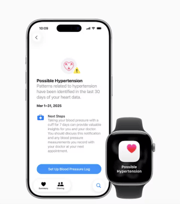Revolutionary virtual hospital makes at home treatment possible!
- Replies 1
We all know how important it is to look after our health. This becomes even more critical as we age, with doctor visits and hospital trips sometimes becoming the norm rather than the exception.
Imagine, then, the possibility of being treated in the comfort of your own home without even needing to travel for a check-up. This isn't science fiction — it's a reality happening right here in Australia, thanks to a revolutionary virtual hospital in Adelaide.
The country's first standalone nationally accredited virtual hospital looks a lot like a call centre, with nurses conducting virtual ward rounds and reviewing patients' wounds through photographs of their injuries.
This innovative approach to healthcare, called My Home Hospital, is a joint venture between Calvary and Medibank and is supported by SA Health.

As one patron, Peter Ellis, who is recovering at home from a sudden leg infection, puts it: 'It's just a nicer experience. Even though the nurses at the hospital are great, it's just nice to be in your own house...and no hospital food.'
The rise of COVID-19 forced a rethink of healthcare practices worldwide and accelerated the adoption of technology to make virtual care a reality.
Some hospitals have opened virtual wards, but My Home Hospital is leading the way as the first nationally accredited standalone operator, admitting public patients straight from GPs, ambulance call-outs, or other hospitals.
Although virtual appointments can never fully replace in-person care, this new approach enables emergency departments and traditional hospital wards to be freed up for those who need them most. In-person visits by healthcare staff are still made when necessary, and if a patient's condition worsens, a paramedic can be dispatched.
Dr Emily Kirkpatrick, the Executive Medical Director, believes this virtual solution is truly changing the game for healthcare in Australia.
'These patients can be really unwell, often needing blood tests, imaging, oxygen therapy—all of that we deliver directly to the patient in their home,' she says.
'We see this being a true game changer as to how we're going to deliver future healthcare in this nation.'
With about 100 patients already enrolled, My Home Hospital is acting as a frontrunner for other states to monitor its progress. Home care also offers the added benefit of reducing hospital-acquired complications.
Federal Health Minister Mark Butler recognises the potential for this innovative healthcare service to transform the accessibility of medical care across Australia, stating how he's keeping an eye on 'how it might be adapted to further improve the accessibility of services across Australia'.
This news comes in the wake of a recent report by the Australian Medical Association (AMA) that has shed light on the concerning condition of Australia's healthcare system. The report exposed a significant backlog in public hospitals throughout the country.
According to the AMA's Australian Public Hospitals in Logjam report, out of the 201 public hospitals that were analysed, only three are managing to provide care within the recommended timeframes.
To put things into perspective, in the previous year, a mere 15 out of the 201 hospitals received a positive rating across all performance indicators.
Professor Steve Robson, the President of the Australian Medical Association (AMA), has highlighted several key factors contributing to the growing dilemma in our healthcare system. These include critical shortages in the workforce, the lack of available hospital beds at crucial times, escalating instances of ambulance ramping, and emergency departments operating beyond their limits.
With these concerns in mind, Professor Robson earnestly calls upon all Australians to actively engage in the matter. He urges citizens to visit the campaign website, where they can both share their personal hospital experiences and access information regarding the performance of their local healthcare facilities.

It is undoubtedly appealing to consider the possibility of receiving medical treatment in the comfort of your own home. What are your thoughts on this development?
Are you excited about the idea of having checkups and treatments at home? Or do you still prefer the traditional method of meeting your doctor in person and having them personally assess your condition? Feel free to share your opinions in the comments section! We are eager to hear from you.
Imagine, then, the possibility of being treated in the comfort of your own home without even needing to travel for a check-up. This isn't science fiction — it's a reality happening right here in Australia, thanks to a revolutionary virtual hospital in Adelaide.
The country's first standalone nationally accredited virtual hospital looks a lot like a call centre, with nurses conducting virtual ward rounds and reviewing patients' wounds through photographs of their injuries.
This innovative approach to healthcare, called My Home Hospital, is a joint venture between Calvary and Medibank and is supported by SA Health.

A new hospital that allows patients to be treated virtually while remaining at home has been unveiled. Credit: Pexels/Anna Shvets.
As one patron, Peter Ellis, who is recovering at home from a sudden leg infection, puts it: 'It's just a nicer experience. Even though the nurses at the hospital are great, it's just nice to be in your own house...and no hospital food.'
The rise of COVID-19 forced a rethink of healthcare practices worldwide and accelerated the adoption of technology to make virtual care a reality.
Some hospitals have opened virtual wards, but My Home Hospital is leading the way as the first nationally accredited standalone operator, admitting public patients straight from GPs, ambulance call-outs, or other hospitals.
Although virtual appointments can never fully replace in-person care, this new approach enables emergency departments and traditional hospital wards to be freed up for those who need them most. In-person visits by healthcare staff are still made when necessary, and if a patient's condition worsens, a paramedic can be dispatched.
Dr Emily Kirkpatrick, the Executive Medical Director, believes this virtual solution is truly changing the game for healthcare in Australia.
'These patients can be really unwell, often needing blood tests, imaging, oxygen therapy—all of that we deliver directly to the patient in their home,' she says.
'We see this being a true game changer as to how we're going to deliver future healthcare in this nation.'
With about 100 patients already enrolled, My Home Hospital is acting as a frontrunner for other states to monitor its progress. Home care also offers the added benefit of reducing hospital-acquired complications.
Federal Health Minister Mark Butler recognises the potential for this innovative healthcare service to transform the accessibility of medical care across Australia, stating how he's keeping an eye on 'how it might be adapted to further improve the accessibility of services across Australia'.
This news comes in the wake of a recent report by the Australian Medical Association (AMA) that has shed light on the concerning condition of Australia's healthcare system. The report exposed a significant backlog in public hospitals throughout the country.
According to the AMA's Australian Public Hospitals in Logjam report, out of the 201 public hospitals that were analysed, only three are managing to provide care within the recommended timeframes.
To put things into perspective, in the previous year, a mere 15 out of the 201 hospitals received a positive rating across all performance indicators.
Professor Steve Robson, the President of the Australian Medical Association (AMA), has highlighted several key factors contributing to the growing dilemma in our healthcare system. These include critical shortages in the workforce, the lack of available hospital beds at crucial times, escalating instances of ambulance ramping, and emergency departments operating beyond their limits.
With these concerns in mind, Professor Robson earnestly calls upon all Australians to actively engage in the matter. He urges citizens to visit the campaign website, where they can both share their personal hospital experiences and access information regarding the performance of their local healthcare facilities.
Key Takeaways
- A new virtual hospital has been unveiled in Adelaide, allowing patients to be treated while remaining at home in their own beds.
- The hospital is a joint venture between Calvary and Medibank, delivering My Home Hospital for SA Health, and is the first nationally-accredited standalone operator.
- Patients can receive a range of treatments and services, including blood tests, imaging, and oxygen therapy, all while staying at home.
- The innovative approach not only frees up emergency departments and wards but also results in a lower rate of hospital-acquired complications.
It is undoubtedly appealing to consider the possibility of receiving medical treatment in the comfort of your own home. What are your thoughts on this development?
Are you excited about the idea of having checkups and treatments at home? Or do you still prefer the traditional method of meeting your doctor in person and having them personally assess your condition? Feel free to share your opinions in the comments section! We are eager to hear from you.







